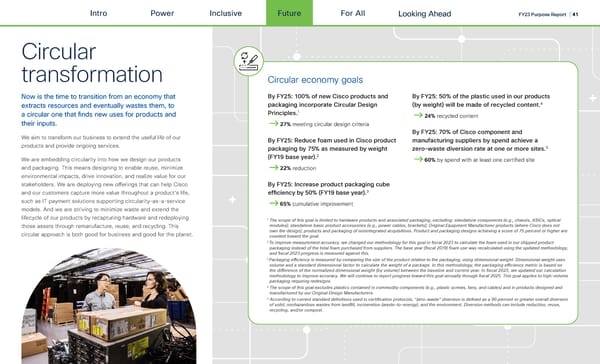Intro Power Inclusive Future For All FY23 Purpose Report | 41 Looking Ahead Circular transformation Circular economy goals By FY25: 100% of new Cisco products and By FY25: 50% of the plastic used in our products Now is the time to transition from an economy that extracts resources and eventually wastes them, to packaging incorporate Circular Design (by weight) will be made of recycled content.4 1 a circular one that 昀椀nds new uses for products and Principles. 24% recycled content their inputs. 27% meeting circular design criteria We aim to transform our business to extend the useful life of our By FY25: 70% of Cisco component and products and provide ongoing services. By FY25: Reduce foam used in Cisco product manufacturing suppliers by spend achieve a packaging by 75% as measured by weight zero-waste diversion rate at one or more sites.5 We are embedding circularity into how we design our products (FY19 base year).2 60% by spend with at least one certi昀椀ed site and packaging. This means designing to enable reuse, minimize 22% reduction environmental impacts, drive innovation, and realize value for our stakeholders. We are deploying new o昀昀erings that can help Cisco By FY25: Increase product packaging cube and our customers capture more value throughout a product’s life, 3 ef昀椀ciency by 50% (FY19 base year). such as IT payment solutions supporting circularity-as-a-service 65% cumulative improvement models. And we are striving to minimize waste and extend the lifecycle of our products by recapturing hardware and redeploying 1 The scope of this goal is limited to hardware products and associated packaging, excluding: standalone components (e.g., chassis, ASICs, optical those assets through remanufacture, reuse, and recycling. This modules); standalone basic product accessories (e.g., power cables, brackets); Original Equipment Manufacturer products (where Cisco does not circular approach is both good for business and good for the planet. own the design); products and packaging of nonintegrated acquisitions. Product and packaging designs achieving a score of 75 percent or higher are counted toward the goal. 2 To improve measurement accuracy, we changed our methodology for this goal in 昀椀scal 2023 to calculate the foam used in our shipped product packaging instead of the total foam purchased from suppliers. The base year (昀椀scal 2019) foam use was recalculated using the updated methodology, and 昀椀scal 2023 progress is measured against this. 3 Packaging e昀케ciency is measured by comparing the size of the product relative to the packaging, using dimensional weight. Dimensional weight uses volume and a standard dimensional factor to calculate the weight of a package. In this methodology, the packaging e昀케ciency metric is based on the di昀昀erence of the normalized dimensional weight (by volume) between the baseline and current year. In 昀椀scal 2023, we updated our calculation methodology to improve accuracy. We will continue to report progress toward this goal annually through 昀椀scal 2025. This goal applies to high-volume packaging requiring redesigns. 4 The scope of this goal excludes plastics contained in commodity components (e.g., plastic screws, fans, and cables) and in products designed and manufactured by our Original Design Manufacturers. 5 According to current standard de昀椀nitions used in certi昀椀cation protocols, “zero-waste” diversion is de昀椀ned as a 90 percent or greater overall diversion of solid, nonhazardous wastes from land昀椀ll, incineration (waste-to-energy), and the environment. Diversion methods can include reduction, reuse, recycling, and/or compost.
 Cisco FY23 Purpose Report Page 41 Page 43
Cisco FY23 Purpose Report Page 41 Page 43